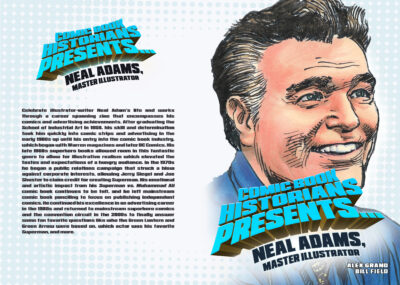Mark Texeira and Jimmy Palmiotti Interviews by Bill Field & Alex Grand
Check out Alex Grand & Bill Field’s biographical zine on Neal Adams in Comic Book Historians presents… Neal Adams, Master Illustrator!
meanwhile enjoy the show…
Go to 12:32 of the CBH Podcast episode above to listen to this combined interview.
Bill: We have come upon one of my favorite artists, and I think Alex will agree with me, and it’s the great Mark Texeira. Mark, it’s an honor to have you, buddy!
Mark: Thank you, thank you. Yes, so I’m here with Vanguard. I have also another table back by artist alley. I really like being over here; I think this is where all the artists … Bill Sienkiewicz, Neal Adams, all the greats are hanging out here. So I’m kind of torn; I think I’ll be here next year.
Bill: We’ve been talking to you a little bit before the interview, but we’re talking about our great passion for the great classic artists like Hal Foster–
Mark: Yes.
Bill: Like after him Wally Wood. And then we get to you a few years later.
Mark: There’s a Copper Age and a Silver Age and then there’s an Aluminum Foil Age. What are we? Are we Microwave Age?
Bill: We’re in the Micro-Age, yes.
Bill: Would you tell our fans out there and the listeners, would you tell them a little bit about yourself and where you came from to get to comics?
Mark: Okay, okay, okay. I was born in Manhattan, upper Manhattan, like near Spanish Harlem; raised in the Bronx. My father was a janitor and so that scared me into doing anything but being under sinks and toilets. And I loved comics.
Mark: And one of my first memories of comics … Now, we were so poor, on welfare in New York, that there was this … They’re not a comic book; we didn’t have comic book stores in the 70s, but we had a store that sold cigarettes and they had used comic books for five cents, and they were 25 back then. So that’s where I picked up my first Spiderman, The Death of Gwen. Years later all these books were in boxes so I kept flipping through these, and for a quarter I could get five instead of buying a new one for 25 cents. So that got me into my addiction to comics.
Mark: After that, at the age of 14, somewhere around seventh grade, I had a bunch of buddies in school; we discussed who certain artists were. We would literally say like who’s artwork is this? And I Would go, and we had to learn Buscema’s name, Kirby’s name, Barry Smith, all these artists. I didn’t like Joe Kubert at first when I saw his work, this was on Tarzan, but then I learned how he came from a legacy of Hal Foster, and of course before him I believe it was Charles Dana Gibson at the … But we were discussing that earlier.
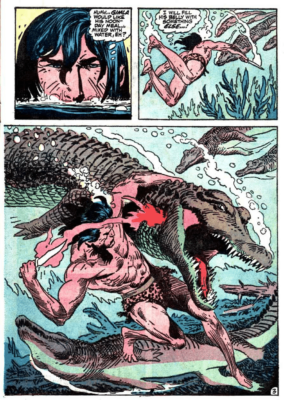
Mark: But I’m such an illustrator lover, having been an illustrator a little bit on my own, I did a few articles for the New York magazine and a few other small things. But comic books just took my interest because I love telling the stories. And now they’re becoming movies. I just got my third credit in the Marvel movies. We created 1990s and Marvel Knights Black Panther’s female assistants, the Dora Milaje. We didn’t even know that they were going to end up in the movies! And one of the women is being played by The Walking Dead Michonne. So I’m so happy. She didn’t exist till I came and created, and now I’m in the atlas of Marvel Comics.
Bill: And cinematic history, Marvel cinematic, and that’s amazing, isn’t it?
Mark: Jimmy Palmiotti’s here. Jimmy, say hi to the fans.
Bill: Thank you, Jimmy Palmiotti.
Jimmy: And there’s no box at the table yet. Yet.
Bill: Jimmy Palmiotti. Amazing artist and amazing human being from what Mark Texeira said.
Mark: All I needed to know was 90 degrees is up, not up. I had to draw this panel nine times, and I drew the gun where it was instead … I kept drawing it like this, and then Jimmy just gave me this point up, this has to be in upward fashion.
Jimmy: Boom. The head goes off. What’s this? Yosemite Sam. I didn’t sign them. Mark Texeiria and I went to high school together, the high school of art and design in Manhattan. And Mark was one of the guys that would come in in the morning, like seven in the morning. They had a painting class. Two hours before each day they would go downstairs and they would paint in the building. And Mark would go every morning down there and paint these amazing like photo-realistic scenes of people on the street, people on benches, cops, all that kind of stuff. And it was very few people that were that devoted.
Jimmy: Think about your own high school, right? If somebody told you to come in two hours early to do something, you don’t want to hear it. And Mark would come all the way from the Bronx to Manhattan, come in two hours early, paint, paint, paint; nine o’clock comes, bang, he run upstairs and do all his classes. Yeah. … He was one of the guys when I was in high school that was like this guy is going to be huge one day because look at the drive, look at the talent, and then we don’t know what happened then. And that’s … I’m kidding, I’m kidding, I’m kidding.
Mark: He had so much promise!
Jimmy: So much promise! We don’t know what happened! The internet destroyed him. No, no–
Mark: That’s funny.
Jimmy: So when I was working in advertising, and I wanted to get into doing comics, I was 30-years-old; 28, 29, 30, around there. And Mark was actually drawing Punisher and Ghost Rider at the same time monthly. He was drawing two monthly books.
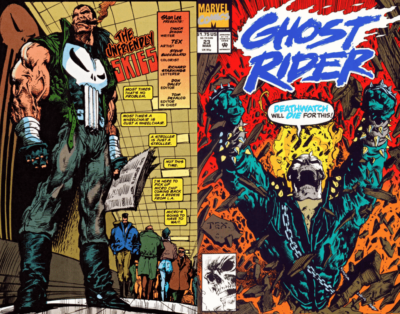
Mark: My wife was so proud of me.
Jimmy: So how I got into Marvel and how I got into the business, Mark said can you please come and give me a hand doing backgrounds and helping me with the pages? So I used to say sure if I can go up to Marvel Comics and work on them because I just wanted to get in the offices and maybe pick up work. And Mark and I would work all through the night. We’d eat donuts and drink soda, and it was like disgusting, but we needed the energy to stay up.
Jimmy: We noticed chocolate donuts would be giant monkey’s a$$holes. But anyway, we would eat those and we would go on pure sugar, and we was getting these two books in a month. Like boom, boom, boom.
Mark: Working till like six in the morning, seven in the morning. Yeah.
Jimmy: And they are classic runs, the characters. And then years later when Joe Quesada and I did Marvel Knights, we got Black Panther as one of the characters and I said Tex’s got to draw it. And actually Tex not only drew it, but he painted it.
Mark: But Jimmy, you forgot. As soon as you were helping me, Don Daley came by and I introduced him, and then he started working with Don Daley and then it was new history.
Jimmy: Yeah. I know how to network and how to get in there. And basically comics was basically are you decent? Yes. Can you get it in on time? Yes. And editors are genetically lazy people, so they don’t want to do a lot of work. They want it to come in and be done so they can have some time off or get on to the next book.
Jimmy: So what I learned from advertising is the more you get done and make their job easier, the more they want to hire you. And that’s pretty much how I got a lot of my work.
Jimmy: But Mark was the guy that brought me in, and he’s still a mega talent. A career is like a roller coaster, and we’re still on the roller coaster.
Mark: Yes! Love it. Love it.
Jimmy: We might slow down, but we’re on the tracks. I always say, people like it’s a roller coaster; no, we’re on the tracks, though.
Mark: This is my 40th year. I started in 1980.
Jimmy: You started with Neal Adams, too, right? You worked with Neal?
Mark: In 88.
Jimmy: 88.
Mark: Yeah, I was with Vince Colletta and Joe Orlando. They sent me over from Marvel; they said John will need to you see you. He said look, kid, at 19 we don’t print anybody who hasn’t been published. So go over to DC Comics; here’s Vince and Joe Orlando’s numbers. So I went over there and they started giving me work in House of Mysteries and Tales of Terror, and then I went to He-Man and then the Warlord, and then Hex, and then I went to Marvel.
Jimmy: Funny thing. So Frank Frazetta. We went up to Frank Frazetta’s house and Mark brought his paintings. And Frazetta said it was one of the most impressive paintings he’s ever seen capturing movement, which was Frank’s thing, right? Mark’s head almost exploded when Frank was complimenting him, but I’ve never seen Frank compliment somebody like he did Mark’s painting abilities. And it’s a shame where he is now, like I said. No.
Jimmy: To see Frank Frazetta flipping through your paintings, how cool was that? Because that was like the god of everything, of painting there.
Mark: From this entire floor of San Diego Con.
Jimmy: Sincerely blown away. The history of Mark Texeira. I know a lot more, but I don’t want to say those stories.
Bill: Great words from Jimmy Palmiotti, but now we want to focus a little bit more on you, Mark, before we have to leave. I’d like to ask you real quick, what are you working on now? Tell us a little bit about the Looney Tunes crossover book.
Mark: Yes. After Jimmy’s wonderful intro to this wonderful world, I’m working with Frank Tieri on another Warner Brothers DC crossover, Yogi-Bear versus Deathstroke. Hanna-Barbera or Warner Brothers owns DC Comics, Warner Brothers also owns Hanna-Barbera, so they’re doing the crossovers in the comics. Unfortunately this Yogi is not your lovable Yogi. This is not a hat-wearing, collar-dressed bear. This is a demon bear that stands about 15 feet high, and somehow it abducts a woman or something and the ranger has to call in Deathstroke to save this woman from Yogi.
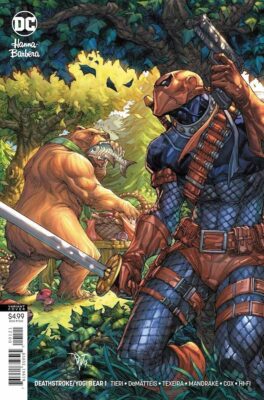
Bill: That’s amazing.
Mark: That’s what I’m about to start working on, after San Diego Con.
Mark: Yeah. 64-page Die Hard. It killed me. It was done about two weeks ago; it’s finished finally. And it’s the 30th anniversary of Die Hard, written again by Frank Tieri, a buddy of mine who I haven’t seen the entire convention so far. It’s been two days; where is he? So that’s what I’ve been working on, yes.
Mark: And cards for Upper Deck, the Marvel series; only card collectors know about that. And then there’s lots of in-betweens, you know.
Mark: And we’re representing Vanguard; we’re standing under their booth.
J. David Spurlock: There’s some talk about a second Vanguard art collection.
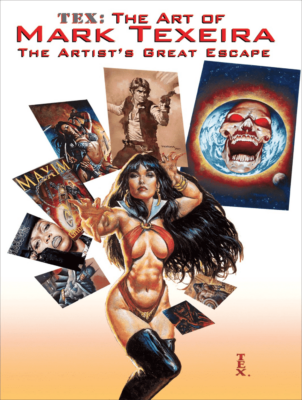
Mark: Oh, please. Yes. With my name on it, I hope.
J. David Spurlock.: A second Vanguard-Texeira art collection.
Bill: Well, Mark we want to thank you. Alex and I would like to thank you so much for this great interview, and we hope you have a wonderful con!
Mark: Thank you, guys. And hopefully see you next year!
Bill: You bet.
Mark: Mahalo, my brothers!
Join us for more discussion at our Facebook group
check out our CBH documentary videos on our CBH Youtube Channel
get some historic comic book shirts, pillows, etc at CBH Merchandise
check out our CBH Podcast available on Apple Podcasts, Google PlayerFM and Stitcher.
Yogi/Deathstroke ©Hanna Barbera/DC Comics, Ghost Rider and Punisher ©Marvel Comics, Tarzan ©ERB, Images ©Their respective copyright holders
Use of images are not intended to infringe on copyright, but merely used for academic purpose.
Interview © 2021 Comic Book Historians








